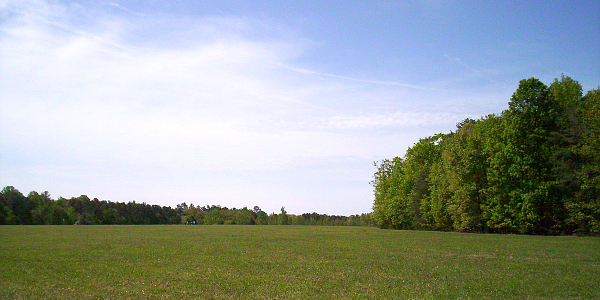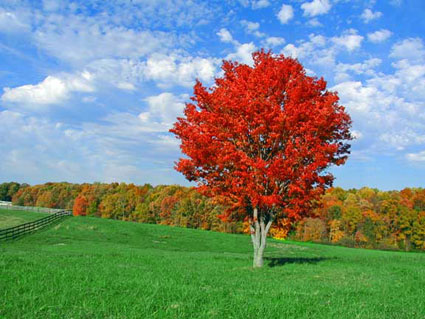
Above photo is of a group of Union soldiers filling their canteens during the Wilderness campaign. Photo courtesy Library of Congress. Right: Visitors on battle walk through the Wilderness forest.

Battle of the Wilderness
It would begin the Overland Campaign, the bloodiest campaign of the Civil War, and by the end of it, the eastern theatre of the Civil War would be changed forever, and lead to the end of the war. On May 5-6, 1864, General Ulysses S. Grant's Federal troops would engage in a bloody struggle along two roads, the Orange Plank Road and Orange Turnpike against his counterpart, Robert E. Lee. When you visit the Wilderness battlefield unit of Fredericksburg and Spotsylvania NMP, you'll notice a big difference in how the battlefield looks than in the units of Fredericksburg or Chancellorsville. It's true of Spotsylvania, even more so, but here at the Wilderness, the open nature of the fields translate into an easy interpretation of how the battle was pursued.
Click here to Sponsor the page and how to reserve your ad.

Battle of the Wilderness Then
This place was so wild, thick with thickets and jungle undergrowth, soldiers from both Confederate and Union armies, plus a fire. It was not the place to be in the spring of 1864. General Grant had reorganized the Army of the Potomac once assuming command of the entire federal army. Corps commanders were now Warren, Sedgwick, and Hancock, plus the independent 9th Corps of Ambrose Burnside. For General Robert E. Lee, he was counting on Confederate commanders A.P. Hill, Ewell, and Longstreet.
In 1864, this was the wildest area, perhaps, fought within the Virginia theatre of the war. Soldiers could barely move through the thickets. They had a hard time knowing where not only the enemy was, but where their compatriots stood. It wasn't an area to have a large scale battle in. But this is where they were. And what generals of the Confederacy had learned about U.S. Grant up to this point of the war was true here, too. He did not stop because battle was hard. Grant pushed forward, in loss and victory.
Image above: Lithograph of the Battle of the Wilderness, Currier and Ives, circa 1864. Courtesy Library of Congress. Below: Expanse of the Widow Tapp Field, one of the few open spaces among the farms and fields of battle at the Wilderness. The Tapp farm was the headquarters on May 5 of General Lee. The battle there occurred in the early morning the next day with initial Union success before a counterattack by Longstreet's forces.

Battle of the Wilderness Now
There is an eight stop driving tour around the Wilderness battlefield, nine if you include Ellwood. At Stop 2, the Exhibit Kiosk is manned by park rangers on weekends and holidays. The Wilderness battlefield is the farthest unit from the Fredericksburg area, but not far from Chancellorsville, and it leads nicely into Spotsylvania, too.
When you walk or drive around the Wilderness unit, you'll be amazed at the thickness of the woods, but what you're seeing isn't even close to the thickness at the time of the battle. There were farms here and certainly are now; it's pretty easy to see the contrast about what fighting on open ground or in those woods would have been like when you walk the paths and read the waysides that explain the battle.
There is no visitor center at the Wilderness unit, only a kiosk that is manned during some hours. And the interpretation here is lower than at the other locations, with ranger walks during the summer from the kiosk, but it is a predominantly visitor by yourself experience here. One where you can wander and contemplate. There are walking trails to take; Gordon Flank Attack Trail, the Vermont Monument, Grant's Knoll, Chewning Plateau, and Tapp Field. The Ellwood home, which was owned by the same family that owned Chatham (can you imagine having both of your homes taken over for headquarters during two separate battles) is open during some hours for tours as well.
Minute Walk in History
160th Anniversary
Take a walk, talk, and tour with @americasbesthistory and the excellent park rangers around the 160th Anniversary events of the Battle of the Wilderness. The Wilderness was the first battle of the Overland campaign and first conflict of Grant versus Lee. Including the opening battle at Saunders Field, the headquarters at Ellwood plantation, the battle at Tapp Farm, and more.
T-Shirts and Souvenirs

Battle of the Wilderness T-Shirts and Souvenirs. Great for fans of the Civil War and American History.

Wilderness
Things You Should Not Miss
1. It's not the easiest park to get interpretation on, but if you're fortunate enough to be at the kiosk during the time of the 45 minute tour, usually on weekends and holidays two times per day, take it. The exhibit shelter is located off Route 20.
2. Take a tour of Ellwood, the working farm manor home that was part of a 5,000 acre estate at the time. During the battle of the Wilderness, it served as a Union headquarters, serving corp commanders Warren and Burnside. Grant's headquarters was on the property, three hundred yards north, but not in the home. Ellwood is only open on weekends and holidays; check for specific times.
3. Sit around a campfire at night and listen to a park ranger give a talk on a variety of topics about the battles of Fredericksburg, Chancellorsville, Spotsylvania, and the Wilderness. It's just a great and relaxing coda to the day. If they're holding one at Ellwood on the day you visit, take the opportunity to join in. There are also, at times, History at Sunset, programs in the summer on the Wilderness Battlefield as part of the once per week series at all sites of the Fredericksburg and Spotsylvania National Military Park.
Photo above: Campfire program at night outside the Ellwood Mansion on the Wilderness Battlefield.
Minute Walk in History
Follow us on a walk and ride around the Driving Tour of the Battle of the Wilderness, the first battle pitting General U.S. Grant for the Union against General Robert E. Lee for the Confederates. The fighting in the dense forests caused great casualties; more for the North than the South, though the battle is considered a stalemate. Narrated from the official records from a summary of General Meade's perspective.






